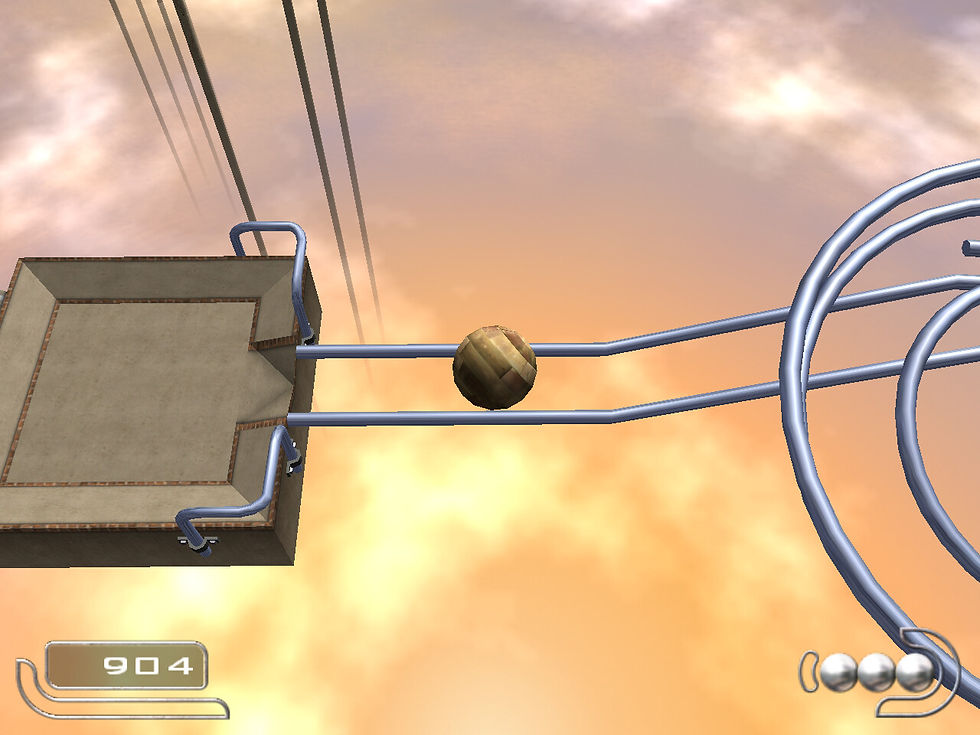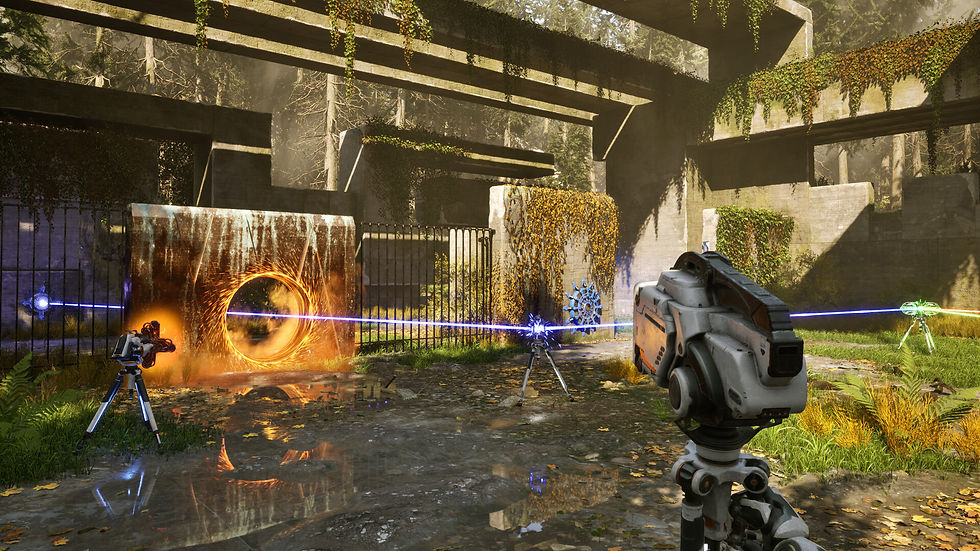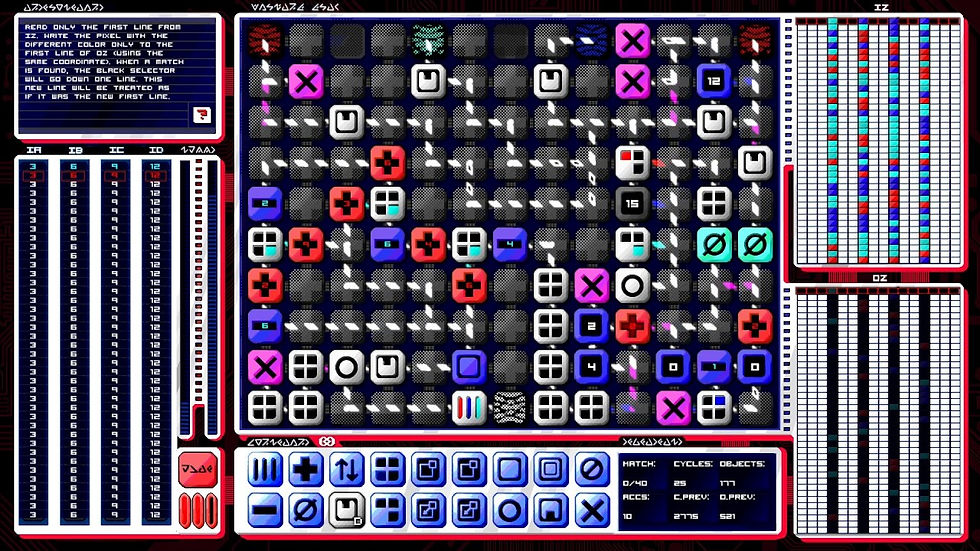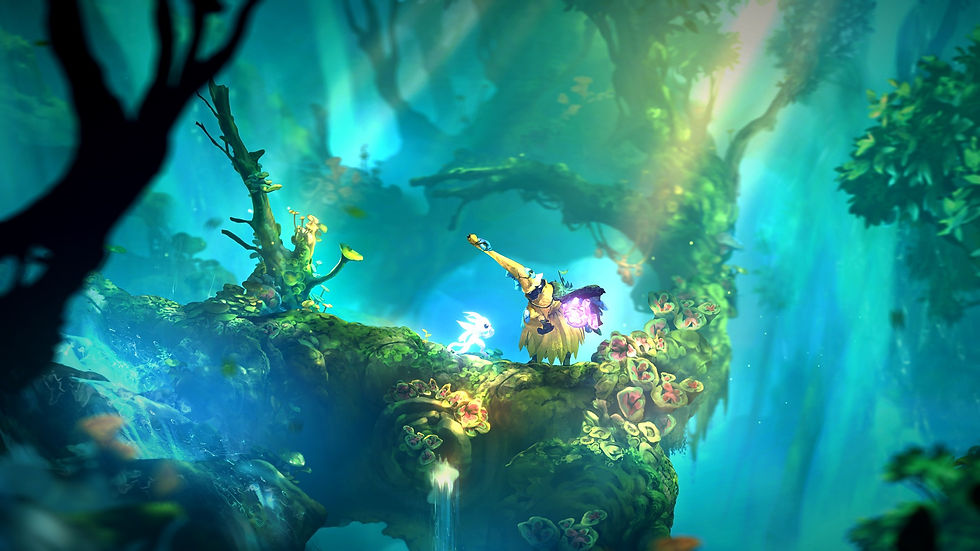My Top 16 Video Games (As of 2025)
- 89o
- Jul 30
- 14 min read
Spoilers: Actually I won't put spoilers here this time so as to not spoil the list itself (:
I like talking about art I like. I've already done music tracks (although that list is now heavily outdated), so now I'm doing games.
This list will be somewhat based on game design and polish, but really the most important factor is my personal connection to the piece. This approach was inspired by Shagrot's PvZ plant ranking video, where I found it to be much more engaging and entertaining than a ranking based on "objective value".

Honorable Mention: Ori and the Blind Forest (Moon Studios)
I'll be perfectly honest. This game is only here because of two rooms, and how amazing it feels to be in them. First is the Lost Grove, a magical tropical beachy area at the end of the Black Root Burrows side-area, pictured above.
I mean come on. It's just gorgeous, the colours are so vibrant (unlike most of the game). And undoubtedly it was the inspiration for the second Ori game's Luma Pools, another amazing area. The Lost Grove simply feels so... delightful... to be in − especially since there's no roof, just a beautiful clear blue sky.

The second is a bit more specific, and quite a bit more personal: this single room in Sorrow Pass. The entirety of this area is this subdued orange colour, and the music is among my top 100 tracks of all time. It reminds me a lot of mountaineering in Spain, with the dry vegetation and rocky terrain, so bonus points for nostalgia. And this specific room just kind of epitomizes the whole vibe of this place, with no extra enemies, no hazards, just a single hidden grove with some trees, stacked stones and light rays from above.
Alright, I have officially run out of words to pretend to describe what I feel when I'm in this room. Let's move on.

#16) Ballance (Cyparade)
There are three games that made it on this list for mostly nostalgia reasons, but I can assure you I have come up with some good reasons to keep them on here. The last place on this list is occupied by none other than Ballance. From my memory, this is the first real game I have ever played (or at least that's what I like to believe), and boy is it wonderful. Simple, easy to understand, and yet very unique, especially for its time.
Your abilities are limited to rolling around in 4 directions and moving the camera. And yet level design remains unique and fresh throughout the 12 levels. What strikes me now, though, is how despite the technical and budget limitations, efforts were made to create a story. Or at least to me it seems that way. Not only do the challenges get trickier (with balancing on monorails added in the final level), but the environments and music change in specific ways as well. It's something I described not very well in my first ever video essay, so I'll try to do a better job of it this time.
Every level in Ballance has a unique skybox, but there are only 5 musical themes to share across the 12 levels (going in order 1-5-2-3-1-5-4-2-3-1-3-4). Listen here while reading to get a better idea of my points.
Theme 5 sounds heavy, rainy and polluted, and plays only in levels 2 and 6, creating the impression that you're rising out of the dirty beginnings into clearer skies.
Theme 4 is the classic climactic theme, playing in levels 7 (halfway point) and 12 (finale).
Theme 2 is lighthearted and very short, and plays in levels 3 (after the polluted level 2) and 8 (after the halfway point).
Theme 3 is calm and meditative, and plays in levels 4, 9 and 11. In particular the last two are interesting, since they're only 2 levels apart, creating a sense of "quiet before the storm".
Theme 1 sounds hot and alien, and plays in levels 1, 5 and 10. And that last one is super interesting, because while 1 and 5 have bright, sunny, orange skyboxes that fit the music, level 10 takes place above Mars, with a distant, alien skybox. The reprise of the level 1 theme here sounds uncanny, creepy − especially if the first melody, with the whole tone scale, plays first (there are 3 short motifs per musical theme that play at random moments in each level).
Now, as with any such loose connection, you could make the point that this was unintentional, and I would completely agree, with the asterisk that such analyses allow us to create similar effects intentionally.

#15) The Treasures of Montezuma 3 (Alawar Entertainment)
The second nostalgia-game, and only upon a recent critical replaying did I realize how amazing this game is. It's a match-3, but also kinda the best match-3 to ever exist. Bejeweled and Candy Crush tremble before Montezuma's might. The whole game is expertly designed to encourage fast-paced gameplay:
The timer for each level is just one minute (aside from time-bonuses), and yet still feels appropriately long.
There is a combo system, and tokens hover in the air for just a split second to allow you to create multiple moves before new tokens fall down. These two mechanics alone create an immense satisfaction upon making a bunch of matches in a row before new tokens are dropped.
There are totems which are activated by matching the same coloured tokens twice or thrice in a row, encouraging quick thinking.
Score frenzy mode is activated upon getting enough points in a short time, and, well, doubles your points − but more importantly, it makes a satisfying sound.
And finally the game juice is perfectly tuned, with the punchy explosions, increasing pitch of combo sounds, full-screen effects with reaching score frenzy, and everything else.
There is literally no other game I know that's this satisfying to play, on a gutteral, animalistic level. And the other games in this same series, even the later ones, are truly pathetic in comparison. There is so much to learn here.

#14) The Silent Age (House on Fire)
I did not expect to like this game as much as I did, but what can I say, I'm a sucker for point-and-click games. This one has a wacky but strangely atmospheric time-travel story, a very likeable protagonist, fantastic art, clever puzzles and a touch of subtle humor, which is what lifted this game high enough to get on this list. This humor is almost exclusively in the form of short quips from the protagonist when you look at items or try to do something that's not the solution to the puzzle.
My absolute favorite line, which I will keep repeating every time I mention this game, is what you get when the developers didn't come up with a unique line for a specific interaction: "Maybe I should try something else." It sounds neutral, and probably was intended to be this way, but picture this: you, the player, are lost and resort to using every item you have on every interactable object. The protagonist comes up with some way to comment on every silly item combination, until at last he kinda realizes what he's doing, holding a rubber ducky trying to unscrew a vent cover, and thinks: maybe I should try something else. I don't know how else to present this, but trust me, it's comedy gold.

#13) Superliminal (Pillow Castle Games)
This is one of those games that keeps you guessing, and keeps amazing you, until the very end. It starts with a concept that can be described in a one-second video clip and amazes you the first time you see it, the kind of concept where I'm positively envious I didn't come up with it myself (but also kinda glad because let's face it, my pace of game development is rather slow).
And the new concepts keep delivering on the surprise factor, as does the storyline of the game. And to be honest, I feel that the moral of the story went over many people's heads, but I seriously enjoyed it, especially the humor. I well and truly consider this a worthy successor to Portal 2, nay, it's well and far better than it. The only thing it's lacking is a regular playerbase... playing battle royale mode was fun when there was someone to play it with.

#12) Octopticom (UP DEVELOPMENT)
The screenshot does not quite scream quality and polish, but this game is the absolute pinnacle of "zachlike" design. For the uninitiated, a zachlike is a problem-solving game where you need to solve a task with a set of tools and a sandbox to play around in – think factory builder or programming simulator. (Yeah, I know, that doesn't sound too fun to most normal people.)
Octopticom involves redirecting light through various filters, logic gates and accumulators to send specified colours to the output recepticles. On the screenshot above you can see the complete list of components throughout the entire game (and 10 of them are just variations – to highlight how few "unique mechanics" there are). I am very, very impressed by the versatility of this "programming language", how many unique challenges can be created with these elements, and how far you can optimize each of these challenges. But while this is definitely the best-designed zachlike on this list, it's not the best zachlike overall, for reasons such as the... overly simple... visual design.

#11) Pistol Whip (Cloudhead Games)
It's a good thing 16 is just as much a cool number as 15, because it means I can include this VR gem.
While I accept that VR is not for everyone, well, it totally is for me. I've been having an absolute blast so far, and Pistol Whip is potentially the most fun I've ever had working out. I'm not much of a sports person, I tend to only do it when school requires me to. But here – three stages on easy mode and I am sweating profusely. Jood Jame.
One tiny detail that absolutely pulls this game up is the dancing men. To clarify, the gameplay usually consists of shooting men in suits who are trying to shoot you, in tune to the beat – but sometimes there are men who are just standing around dancing. It really sells the whole "being inside of a music video" feeling and it's so fun.

#10) The Talos Principle 2 (Croteam)
There are few games that I've been anticipating as much as this one. You know that feeling when just looking at the screenshots is enough for you to... patiently wait for a sale, and then throw your money at the screen as hard as possible? I've had that experience with only one other game, higher up on the list. Not even top-notch puzzle design can beat the thrill of exploring a new world, with new graphics, new mechanics, new story elements, new game structure, and that is really the most important factor of TTP2 (and its DLC) to me. The expert writing, new story directions, completely stunning visuals and exotic-but-familiar soundtrack are just the four cherries on top.

#9) Hotline Miami (Dennaton Games)
I believe this is where we approach "art-game" territory, where the vibes, message and uniqueness play the main role. Although truth be told, Hotline Miami does also happen to be really fun at the same time. I am surprised by how effective the "crappy" art style is (I mean, just look at those janky black one-pixel outlines – that's the kinda stuff I'd draw for fun as a 9-year-old during ICT classes), together with the minimal storytelling and UI, and absolutely punishing and "seemingly unbalanced" fast-paced gameplay.
This is one of those cases where I'd consider the lack of UI, accessibility features, QoL and other stuff that AAA's consider as vital for a video game as code, to be an artistic choice that improves the experience. And while I don't know if this game is 100% accurate to the psychology of actual serial killers... the amount of exhilarating fun I had clearing out a mansion of Russians was chilling.
Bing chilling.

#8) Mind-Machine Interface (izark / ABI-DOS SOFTWARE)
This game has been in development limbo for... at least 8 years I think? And it's finally been released under the title ABI-DOS, and a fresh coat of paint. And while it does have significant design improvements over the original (which is now only available as a demo on ModDB), in my opinion the new graphics are an immense visual downgrade, from and exotic, far-future, alien computer to just a generic puzzle game. A shred of the original wonder and mystery is still kept, but alas, it's merely a shred.
On its own, the game design here is amazing, it's a really strange programming language that's surprisingly versatile and optimizable, similarly to Octopticom. What really makes this one shine for me, though, is all the tiny, meaningless details that are the reason I love indie games so much: the strange language all over the UI, the haphazard layout of the UI (that red square button in the lower left is the Exit button, for example), the random chat and spam messages hidden in the levels, and the crowning jewel: a "lights off" button in the main menu that allows you to take a look around your... spaceship, I think. It's all these elements that add so so much unique atmosphere to what would otherwise be a typical zachlike. Shame it's gone now.

#7) The Witness (Jonathan Blow)
The prime example of what it means to go all out on just one specific concept. This game is a bit too popular for it to be worth my time dissecting it, but it just constantly surprised me with its new interpretations of its "main mechanic". And the cave challenge, while unbearably frustrating, was a very fitting secret for the most dedicated players to prove their worth. My only complaint is the story is a bit too cryptic – I know literally (and I mean literally) nothing about the story after 100%ing the game. If you want to go cryptic, at least give us some starting point, Jonathan.

#6) EXAPUNKS (Zachtronics)
Yeah, so this is the best zachlike on this list. While it may not be as mysterious as Mind-Machine Interface, or as ingeniously minimalist as Octopticom, it absolutely nails its atmosphere. No hacking-inspired game feels as good as EXAPUNKS, in part because this is a programming simulator, so the victories absolutely feel real and like actual computery challenges.
There is an equally important part to the atmosphere, however – the story, and how it's presented. You've got your standard visual novel-style cutscenes, but the you've also got a "chatroom" which updates after each level completed. This is genius. It's cheap for the game's developers, and creates an immense sense of realism for each hack you perform. After hacking a snack company to get rid of peanuts from its peanut bar recipe, you then see someone complain they bought a peanut bar that didn't contain peanuts. (And props to the writers for styling the messages to mimic real surfers of the world wide web – most ppl writing in lowercase w/ abbreviations, but some, like Ghast, using proper punctuation, capitalization and grammar. It's all very authentic.)
I must also give credit where credit is due to the artists making unique environments styled for each level, the writers who designed two zines (mini magazines?) to guide you on your hacks, and the ever-amazing Matthew S. Burns for delivering the most concentration-friendly pieces of hacking music I have ever laid my ears upon. It is truly a delight.

#5) Ori and the Will of the Wisps (Moon Studios)
Yep, the other Ori game is much further up the list. Playing these two games side by side, it is amazing how much they've improved. There are so many more lively, interactable details in each scene, the movement of Ori feels so much snappier and more fluid, and the colors are – I think without exaggeration – the best I have ever seen in a video game. Inkwater Marsh (during the storm), Baur's Reach, and Luma Pools come to mind. It's basically the video game equivalent of exploring the world of Avatar. (The good one, not the anime one. Haha get ragebaited idiots)
(One confession I must make is the art I pasted above is not from the game. I'm pretty sure it's concept art, which is an absolute felony – why didn't we get that beautiful area in the game??? Anyway, it's kind of to illustrate my other point about why unused/concept content in media is so magical. But that's a tangent for another blog post...)

#4) Exo One (Exbleative)
I love this game partly because of its beauty, but even more because of its approach to storytelling. While crude, I do very much appreciate the "emotional" and unclear approach it takes to explaining its physics. Which makes sense considering you're trying to explain an alien spaceship that can morph from a ball to a disk at will, increase its gravity 10-fold at will, and... has no space inside for a pilot? How does that work?
We need to stop thinking in human terms and trust their design, says the Pilot. Anyway... it does more than just fly.
???
Yeah, so when media portrays aliens as "little green men" with giant black eyes who speak English with a funny voice, well, it is fun, like in The Fifth Element, but it's difficult to take such a story seriously. I'm much more a fan of the Arrival kind of aliens – completely incomprehensible to humans, wielding powers that we consider magic but for them is just everyday physics. The kind of aliens that are truly alien. And Exo One absolutely delivers. Along with the same minimalism in mechanics that I enjoyed in Hotline Miami and the next game on the list...

#3) LIMBO (Playdead)
This is probably the last game on this list that most people will recognize. And no wonder; LIMBO undoubtedly has made its way to the top of video game canon, and for good reason. It's a pioneer of the "minimalist atmospheric adventure game" genre, and one of few to really excel at telling a story with literally zero excess elements, akin to Ico (which I haven't played yet). I'm a huge sucker for minimalist design (which should be pretty clear by now). And, weirdly, it's one of the few stories that hits harder when you contemplate it later, at least for me.
I loved how each encounter with danger was designed so that you always feel like you just barely escaped, it reminds me of the chases in Ori and the Blind Forest where the thing chasing you changes its speed depending on how far away you are from it – a clever design principle. In this case, it's used to highlight the hostility of Limbo towards our protagonist, and the hopelessness of his quest. This animalistic, primordial hostility, this teeth-and-bone relationship between the environment and the boy stands in stark contrast to the boy's simple, love-driven goal of finding his sister. It paints a bright picture of humanity against a backdrop of animalism and hate, a beautiful expression of love.

#2) Treasure Adventure Game (Robit Games)
I apologize for the screenshot having debug values in view, an unfinished UI and a gamestate that's impossible to reach normally (you always collect the paper hat before unlocking the parrot or the sail). TAG is just so obscure that this is one of the only good screenshots of it in existence.
I suppose my love for this one does come down to nostalgia to some extent, but now that I'm contemplating it fully, it really strikes me how intentionally game-y, childlike, and just plain fun this game is. The title says it all: Treasure Adventure Game. It's only when you keep playing do you discover the darker secrets hidden in this world that at first glance seems to be designed by a 10-year-old. This juxtaposition creates one of the most impactful moments I have experienced in a video game, which is something I mentioned in my "when bad is better" essay.
But I think what brings this game to #2 is simply the fact that it feels like it belongs in video game canon as much as Pac-Man or Super Mario Bros. Its totally game-y energy, classic pixel art style, bopping chiptunes and cliché-but-also-unique story elements make this an unforgettable experience.
(Oh, and if you're considering playing the remake, Treasure Adventure World – don't. It's bad. Trust me.)

#1) Submachine: Legacy (Mateusz Skutnik)
Yeah... so what exactly put this one at #1 for me?
In part it's the amazingly unique "dark ambient" liminal atmosphere along with the otherworldly ambiences by The Thumpmonks. But I think this placement is more to do with the sheer amount of content, and the masterful anticipation of much more content in future games. I absolutely adore the feeling of not quite knowing where a video game's boundaries are (basically the opposite feeling of having played a game so many times that you know where each tiny detail is) – and Submachine excels in this.
One method is just having a ton of content in the first place – over 1900 unique rooms according to the Steam page. Another is having redundant or useless content – this may seem a bad choice for a puzzle point-and-click game, but it's actually pretty genius. Having whole locations that do absolutely nothing really creates a sense of the game world exceeding the boundaries of just the puzzle design itself.
Finally, there's the storytelling, again. As I mentioned in my essay about Christianity in video games, new metaphysical concepts and new abilities of the Submachine are being piled on like wet carpets on a secretary. And since these are only "mentioned in passing" in the notes that make up the bulk of Submachine's storytelling, it creates unresolved subplots that are just begging to be explored and explained further. Though I'm pretty sure the developer's intention is to keep some of these forever unexplained.
Ultimately I think this game and Exo One reveal what kind of lore I like best: not "timeline lore", like in FNAF or other mascot horror games popularized by The Game Theorists, but "concept lore", where you're trying to figure out what's happening in the first place, what the metaphysical rules are. And the more outlandish, the better.

![Preparing for The best Liminal Space Game [Devlog]](https://static.wixstatic.com/media/615947_8cb04342d3df40ef822b11b4061678e9~mv2.png/v1/fill/w_980,h_490,al_c,q_90,usm_0.66_1.00_0.01,enc_avif,quality_auto/615947_8cb04342d3df40ef822b11b4061678e9~mv2.png)

Comments